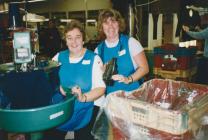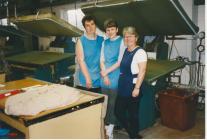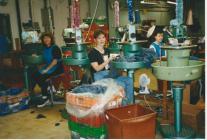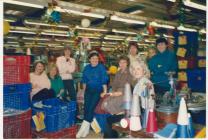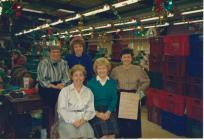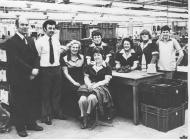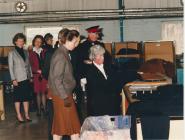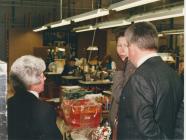Patricia Murray. Voices from the Factory Floor.
Items in this story:
Patricia was born in Betws, Ammanford on 20th October, 1944. Her father was in the army when he met her mother, and then went to work in the mines. He also worked as a painter and decorator. He did quite a few jobs, and before he retired he worked in Delanare.
During the war Patricia’s mother worked in munitions factory in Bridgend. She didn’t work when Patricia and her two siblings were little, but went to work at Delanare later on until she retired. Patricia is the eldest of three children and has one sister and one brother. She went to school in Betws, and then went on to Ammanford Secondary Modern. She left school when she was fifteen years old. She was happy to be leaving school (apart from the Physical Education part of school.) She more or less had a job before leaving school, with two doctors (Dr Stewart and Dr Davies) from Ammanford who owned a factory making bandages. Her mother got her the job by having a word with them before she left school.
Initially her job was packing bandages at Tir y Dail. From there she progressed to weaving the bandages in Penclawdd. The factory moved from Penclawdd to Garnant. When Patricia worked in Penclawdd Patricia was given a lift by the driver of one of the doctors in a big lorry. Patricia describes the experience as ‘horrendous’. She would leave at six thirty in the morning and some evenings she wouldn’t be back until six thirty in the evening because the driver would be delivering the bandages, and the workers on the lorry would have to go with him.
When the factory moved to Garnant it was easier getting to work and travel to work was possible by bus. Patricia didn’t stay there long for the simple reason that the factory wasn’t well run. It was a small place with no heating, and one December Patricia and the other workers decided to walk out. They walked down to Corgi and got another job instantly.
There was only five people working in the bandage factory and the facilities were poor. There was no canteen, and there was a lot of dust and fluff which could potentially have caught fire on one of the heaters. The pay was also poor.
When Patricia started at Corgi she was on a wage of £3.00 and worked as a “linker”. Patricia says that she’s “pretty good” with her hands and progressed to production within five weeks where she could earn £4.00 - £5.00 a week doing piece work. She would time herself, allowing herself a certain amount of time to do a particular piece of work.
During the time that Patricia was at the bandage factory she would go to local dances, “hops”, where she would meet local girls who would talk about their jobs at Corgi and Patricia and her friend Janet were encouraged to go down there to look for work. They were both given jobs. Her friend went on to the knitting and Patricia went on to the linking and she was there for the rest of her life working for Paine’s.
After the walk out at the bandage factory the boys working there had stayed on but there was nobody left to operate the machinery. There wasn’t a boss there as such (the doctors were their bosses.) The driver would pop in now and again, so they were left to their own devices. It was shambolic and they had to close the factory because of the walk out.
Patricia has never been jobless or on the dole.
At Corgi’s there was no interview or test in order to get employment. They were at the top end of Corgi initially and there was only about thirty of them working there. As the company started employing more workers they moved to the bottom of the factory. Later on they moved into John White’s factory.
In 1965 she was due to get married and in the same year she was made up to training instructress (to train the linkers). She was meant to go away to Hathwaite to learn ‘high level linking’. She had to go to find out how to do second linking which was attaching collars. But she couldn’t go because she was getting married. The other supervisor went and on her return showed Patricia what to do, and then Patricia took over the training school. From there she moved on to be a supervisor.
The knitting of the garments was done at the Surrey factory and the sleeves, fronts, backs and collars would be sent down to the factory in Ammanford in order for the garments to be put together. The workers were paid a certain amount for putting a dozen garments together, but there was a different price for each style. They had to cut a little card out and enter the amount in a book. The book went to the office every week. Patricia knew how much she would have earned for each day, and this was how the piece work developed.
The salary in Corgi’s was £3.50 per week compared to £3.00 per week in the bandage factory, so it wasn’t a great increase at the beginning. But after the first few weeks she started earning substantially more through working hard.
Patricia was in the bandage factory for two years, first of all packaging. When they moved down to Penclawdd they started weaving them but Mr Wignall, the man in charge had finished. One of his daughters stayed on after the move until they were trained. The weaving was quite a simple job but the factory was disorganised with nobody in charge and she describes it as a ‘shambles’.
In Corgi’s Patricia’s initial training was undertaken by a supervisor called Yvonne, and then Patricia built up her own speed. She started on a small linking machine called a hague. Her and three others were given a bigger machine as they were considered the best workers and this made everybody else jealous. The larger machine meant they would be able to do more, and therefore earn more money. The girls who were jealous asked they were given the larger machine but Patricia explained it wasn’t her decision but the decision of Mr Jones and Hugh Corgi, and the supervisor. Quality was a consideration. If the work wasn’t up to scratch the items would be returned and they would have to re-do them in their own time. Patricia didn’t have items returned but this did happen to other girls who were rushing to finish their work. Some examiners were keener than others. It was very highly skilled work. There were different gauges - 21, 30, 15, 9 gauge. They were also making cricket sweaters which was a heavier six gauge.
Patricia remembers her first day, and the fact that the factory was noisy, but the bandage factory was equally as noisy. The radio would be on in the factory, playing rock and roll songs, and the workers down the bottom of the factory making socks, together with the Alan Paine workers would jive if a certain record came on. In the bandage factory the girls couldn’t even hear themselves talk.
The atmosphere in the factory was really good. It was a well-lit factory and clean. Patricia kept her own machine area clean. Most of the mess was caused by fluff and waste yarn.
00.14.30: In Corgi work started at eight o’clock and finished at half past four. There would be loads of buses waiting in the parking areas to take the workers home. At half past four Patricia would run out and catch a bus home. They were work buses, many of them were Gareth Evans from Brynaman buses)
Patricia really enjoyed her time at the factory. She knew the managers, and called them by their names. They would come out of the office and chat to the girls. Patricia estimates there were about sixty or seventy people working there then.
Patricia started work at eight o’clock in the morning. There would be a break at ten o’clock for a cup of tea. Some of the girls didn’t bother. They would stay at the machine and carried on in order to earn more money. There would be half an hour’s break for lunch. The workers couldn’t have their tea on the shop floor.
The canteens in both Corgi and John White’s were good. In John White’s the workers had to leave the factory and cross over to the canteen because it was a separate building.
Patricia has always been good with her hands and said that she’s always loved knitting and crochet, and the work at the factory was along these lines. She was shown what she would have to do when she went there to look for work, but wasn’t actually given an interview.
When Patricia was a supervisor at Paine’s they would interview the girls and try them out on the machine to see if they had any aptitude.
Patricia already knew many of the girls working at the factory, as they were from the same neighbourhood. She didn’t need to have qualifications or an interview to work there. They were glad to take on workers but if workers were no good the factory would ‘get rid’ of them.
The training involved being on production but working slowly in order to learn the trade, and being under the constant supervision of the supervisor.
00.18.48: She said,
‘You built up your own speed. You wanted to build it up because you wanted to earn more money.’
Patricia remembers getting her first ‘proper’ pay packet at Corgi’s (unlike at the bandage factory) and showing it to her mother. At the bandage factory they were just given an envelope with ‘a bit of money in’. They didn’t have office workers there. Patricia started as a linker, and never had work returned to her to re-do. When they moved into John White she was promoted to training supervisor. Initially, she trained the girls on second linking. Once they were trained another line would be started – a 9 gauge line and a 15 gauge line. Patricia was then taken out of the training school and put in charge of girls she had trained on the 15 gauge line. She taught herself to seam (on the side seams) so that she was also in charge of them – cuffing and bar tacking.
The completed pieces were still coming down from Surrey, to be put together in Ammanford. They were made from different yarns – Shetland, cotton, cashmere, lambs’ wool, camel hair. After the piece were put together the garments would go back up to Surrey, milled (washed), finished off and packed.
When Patricia moved to Paine’s new factory in 1966 they did the complete process, eventually. They had knitting machines (Patricia’s husband worked on one for a little while), a mill for the washing of the garments, and they packed as well.
When Patricia started at Corgi’s initially there were only women working there. After they had moved they had men on the cable knitting machines and the automatic machines. Of the women working there and their demographic Patricia says, ‘Once you started in that kind of work, you stayed there... Not many of the girls finished to go somewhere else.’ For the girls who had babies a creche was opened in the new Alan Paine factory in order to keep hold of the trained workers. This came about because the training process was so long. They couldn’t afford to bring other people in to be trained. This was in the 1980s. Before that the factory had outworkers, working from home. Patricia herself had a machine at home, and worked from there when her little boy was little, for a period of two years. There were many girls working as outworkers. When Patricia worked as a supervisor she would go out to check the work of the outworkers. Many of the girls couldn’t come back to work, so the factory would arrange to have work taken out to them and collected.
Patricia considers that all the work at the factory was skilled (linking being the most skilled, which was reflected in the way they were paid). Seamers would get through four times the work that linkers would. There were lots and lots of different jobs such as hand sewing. Usually, nobody wanted to link because it was too difficult.
Men and women got on well together. They worked on separate floors. Patricia thinks that the men would have been unable to do the jobs performed by the women.
00.25.38: ‘We all got on grand, there was no hanky panky.’
Patricia’s husband was happy that she continued to work after getting married. They’d talked everything through and they wanted to save for their own home. They started off their married life in two-room accommodation but managed to buy their own house by May 1968, and their son was born in September of that year.
As far as work prospects were concerned it was a case of supervisors spotting potential and recommending individual workers. This is how Patricia became a supervisor – she had been recommended by her own supervisor, Yvonne. Patricia still felt like one of the girls, after becoming a supervisor but when she progressed to the management side, she remembers the boss telling her, ‘Pat, remember now, you’ve got to keep your distance. Be friendly, but only so far.’ But Patricia never had a problem. She would still converse with the girls.
00.28.54: She said, ‘We had a lovely working environment there.’
As a supervisor Patricia was aware that some girls would try and book in work that they hadn’t done. There was a long card listing the first link, second link, etc. On the other side the numbers of the work would be listed but when the girls were trying to pull a fast one the tickets wouldn’t be available. But this didn’t happen often. Every morning the supervisor went around collecting tickets, checking them against the work that had been booked in, and a sheet would be taken to the office every day. Patricia never had a lot of trouble with her workers as a supervisor.
Usually, the outworkers were married women with small children, although when the children got older and started school, they would return to work in the factory. There was a second linker living as far away as Burry Port, and she would have the work taken to her, although she was expected to pay for her own electricity. In this way everybody was happy – the factory and the outworkers. A driver normally took the work out to the outworkers, but Patricia took the work out herself some days.
00.31.30: They were not given a pay rise for a few years when times were hard. In the beginning they weren’t given any pay rises at all anyway, as pay was based on what you’d done. The workers (in the factory) were brought the work in bags, and favoured particular styles because they knew that it was possible to earn good money working on them. There were camel hair cardigans that required having the straps put on but a lot of the girls hated doing them. Patricia enjoyed doing them because they were good ‘payers’. There was a garment which they called the ‘five bobs’ – which only required putting the shoulders together and therefore was simple work. Patricia didn’t like doing these because the work was completed so quickly it meant that she was up and down on her feet all the time. The girls liked different styles. Patricia liked working on cardigans and therefore was earning a lot of money.
When Patricia first started working at the factory she used to go out to dances nearly every night, and this is what she spent her money on. In those days nobody drank anyway. She did pay her mother ‘board-lodge’ of approximately two pounds a week, and anything she earned above that she would be able to keep. This gave her an added incentive to work hard at the factory. Out of her pay packet she would also have to pay for her bus fare to work, although the fares were subsidised by the factory.
The factory would hold sales when they would sell unsold sweaters or seconds that would be greatly discounted.
Patricia only remembers one or two instances of workers taking stuff from the factory. There was a young lad who was going out with his friends for the weekend and borrowed one of the sweaters to wear so that he could brag that he had a cashmere jumper. He brought the sweater back the following day in perfect condition but somebody informed on him and he was dismissed. Patricia was devastated as she was very fond of him, but appreciates that he had to be sacked because he’d broken the factory’s trust in him.
There was a union at the factory, which Patricia wasn’t part of because she was ‘staff’ (management). During the initial years at the factory, there was no union but then the girls got together and decided that they wanted one so they organized it themselves. Although seldom, there were a few disputes and these took place during the winter when work would stop because it was so cold in the factory, but heating was the only issue and there were no disputes about anything else. Patricia feels the workers were treated fairly. During her time at the main factory (Alan Paine) there was one boss called David Wainwright, who was with them the longest. He was very hands on and the type of boss who would muck in, for example he would go in and repair the mill.
00.36.40: ‘We hated him and we loved him.’ He was very approachable, and she feels she could walk into the office and talk to him about anything. There was a good relationship between them, ‘you could shout at him and everything.’ The day they heard that he had been made redundant the whole factory stopped working, even though they were all on piece work. The one who had made him redundant were really shocked at the reaction of the workers.
Patricia worked on the factory floor and as part of the management team and never found anything to complain about. The quality control aspect of the work wasn’t very rewarding. When the work was good nobody would come and say so, but when the work was bad was a different matter.
The girls were given tabards to wear for work, and the supervisors, including Patricia were given overalls to wear. Sometimes the workers were allowed to choose which ones were given, but one year Mr Wainwright chose them. They were bright orange and white Brinylon. When they complained he said he would be able to see where they were in these tabards due to the bright colour.
Patricia doesn’t think that the work was dangerous as such, but the girls needed to be careful when they worked because there was a needle going in and out during the linking. She remembers one girl having a needle in her finger. The mechanics had to pull the machine apart in order to release her finger because it had gone onto the point. She fainted at the machine and was taken up the surgery. But Patricia doesn’t remember any other accidents.
There were rules in the factory. Girls weren’t allowed to smoke. There was a special place for them to go and smoke because the wool in the factory was flammable. Some girls would go out every half an hour for a smoke. They would say they were going to the toilet but would go to the smoking bay but you could smell the smoke on them as soon as they came back. They could smoke during their break, and smoke in the canteen at that time. Quite a few of the girls smoked. The keen smoker who wanted to maximise their chances of earning money would only go and have a cigarette during their break.
As far as Health and Safety is concerned this wasn’t an issue in the early years but as time went on this became increasingly strict to the extent that you weren’t allowed to give a girl a tablet. There was a part time nurse working on the line to do first aid. The ‘staff’ also had to do so much first aid training, and if the nurse wasn’t available a member of staff would be required to administer first aid and log the procedure in the book. When Patricia first became a supervisor she could remove a bit of oil from a jumper with a bit of solution, but as Health and Safety regulations became stricter she would have to wear a mask to do the same procedure. Patricia thinks this ‘spoilt’ many places of work but Patricia thinks that part of the blame lies with the people working there because they were suing for the smallest thing. The same thing happened with the creche – the system was working brilliantly but then rules dictated that they needed one person for every two children of a certain age, which meant that it wasn’t feasible any more. The creche facilites had been good – they’d had toilets built especially for it, they had cots and high chairs. The cost was minimal, the girls were only charged about twenty pounds per week, as the service was subsidised. Mr Wainwright was responsible for this service. Due to Health and Safety rules the workers weren’t allowed to park their cars at the end of the factory where the creche was situated. In the end, there were people coming in from outside to ensure Health and Safety standards were met.
Patricia refers back to the time when there were stoppages at the factory and explains that this was in the early days at the Corgi/John White’s factory. When the girls’ fingers were cold they couldn’t do their work. Nevertheless, a lack of heating was never an issue when they moved location to the Alan Paine factory. In the John White’s factory there were bricks missing from the walls, and therefore it was draughty. The mechanics would try and block them up.
The toilet facilities at both factory locations were good. The Alan Paine factory was purpose built. They started just in one part of the factory. During the move from John White’s they worked all weekend in order to get things ready. They were filthy after moving bags. But the camaraderie was good and staff had come down from the Surrey factory to help. At a later date when the knitting machines were brought into the factory, the other part opened. In the beginning the warehouse was in Fforestfach, and post-packing all the work was taken down there. But as the company started having money problems they couldn’t afford the rent down there and this part of the business was brought back to Ammanford.
With the move to Alan Paine more men came to work at the factory, totalling approximately twenty in all. The men were on shift work.
At Corgi’s the radio was on all day but at Alan Paine’s the radio would go off at certain times of the day, although Patricia claims the girls worked better with the radio on. After the August bank holiday the girls would have a countdown to Christmas. A fortnight before Christmas they’d start singing carols. Patricia and her friend Barbara would decorate the whole make up floor. They were more or less in charge of the Sports and Social Club so they’d have a small raffle every week but at Christmas they’d have a huge raffle, also at Easter which the girls would look forward to. They had good prizes such as a set of suitcases, dishes, cutlery. There would be Easter eggs at Easter and selection boxes at Christmas time. When the factory went into receivership in 1993 (although it was back in business in 1994) there was over a thousand pounds in the Sports and Social Club fund and they didn’t want that money going to the new company so they all decided they’d give it to the local ‘needs’ school. The Sports and Social had started when they moved to the new Alan Paine’s factory. They used to have dinner dances in places such as Caswell Bay Hotel, the Afan Lido. Partners were allowed to go but would have to pay for their tickets. Contributions to the club were compulsory, and the money was taken out of the workers’ pay packet every week. It was up to the individual to make the most of the facilities that the Sports and Social offered. They didn’t hold any sporting activities just ‘the enjoyment side of it’. They also used to go to shows in London, shopping trips and even strawberry picking up in Hereford.
When Patricia worked at Corgi’s she was on piece work, but when she moved to Alan Paine she was paid a flat rate. When she worked at Corgi’s the girls used to come in with a head full of rollers and a head scarf because they were going out every night dancing. But Mr Wainwright put a stop to this after they moved to Alan Paine’s. He would tell the supervisors that this type of thing was not allowed, and the girls just accepted it.
Patricia had her ears pierced in the toilets (which Mr Wainwright didn’t know about).
Patricia did have to tell some of the girls to chat a bit less while they were doing their work when a big order needed completing. She would tell them to ‘play the game’ and they would listen to her, without complaint.
The working week was Monday to Friday, and Saturday morning work was optional. If certain orders needed to be completed the girls were quite happy to work on in the nights as well until six or half past six in the evening. This extra work would be paid at time and a half.
Patricia suffers from tinnitus and has a hearing aid and attributes this to her time at the factory. On the make-up floor where the linking and seaming would take place the noise wasn’t too bad, but because Patricia was ‘on the staff’ she was required to go on the knitting floor which was very noisy. There is a strain on the eyesight over the years as well due to the fluorescent lighting.
Girls who were getting married used to come into the factory in their wedding dresses for the other girls to see them. On the make-up floor the supervisor used to collect a sum like 50p a week from the girls so that if anybody got married, or had a baby a present would be bought for them out of this money. Patricia remembers that Mr Wainwright’s car hit a cow on the way to work. At the following Christmas dinner held at the top of the factory, two of the girls had hired a cow outfit and had a big placard which read, ‘I’m the one that got away’.
01.01.40
Girls had to clock in and out and it wasn’t acceptable to let anyone else do this for you. There were no penalties for being late as it was piece work, although later on it became a flat rate. If someone had to go to the dentist they would have to clock in and out and they would then lose money for the time they were away from the factory.
The food in the factory was good and consisted of a cooked dinner, and chips, and was cheap as it was subsidized. Patricia normally took sandwiches and only ate a canteen lunch occasionally. Lunch time was only half an hour so there was no point leaving the factory.
At Christmas time the workers had a fortnight off work. They would also have all the bank holidays off. During the summer break there was a fortnight’s shut down, but this changed over time, and they could take the time off when they chose (with permission). The reason for the shut-down originally was that one line depended on another to keep going.
When Patricia’s son was old enough she and the family would go on holiday abroad. Before that they would go caravanning to places like Tenby with relatives.
The other girls in the factory came from places like Tumble, Llanelli, Brynaman, Garnant, Glanaman, Llandybie. Patricia is still in contact with a woman called Rose who worked at the factory, and sees her every week. Others she sees less often.
Christmas time at the factory (Alan Paine’s) they’d have a big Christmas dinner. A sketch would be performed, and somebody else might sing. The canteen girls cooked a full Turkey dinner and would be served by members of staff. There was a really good atmosphere and the girls were allowed to have a drink but not when they were at the machines, and not until they were sat down in the canteen. The girls brought their own wine in for the occasion. The canteen only made the main meal. Patricia loves cooking and used to make gateaux for desert and other girls used to bring a trifle in. This would usually be held on the last working day and the girls were supposed to work that morning although not much work would be done. The girls would have decorated their own machine, ‘they were like Christmas trees’. There would also be a children’s party organised by the Sports and Social for the children of the factory workers. Patricia would go shopping for presents for them, and Cliff the caretaker would dress up as Santa Claus. (Mr Wainwright would never have dressed up). The children’s party would be on a Saturday afternoon.
Patricia remembers the actor Bill Owen (from the ‘Last of the Summer Wine’ television series) visiting the factory, and on a different occasion, Princess Anne. Bill Owen had asked if he could come and have a look around. When the factory received the third Queen’s Award, a member of parliament visited the factory (Patricia can’t remember his name.) When Princess Anne visited she travelled by helicopter to the local rugby field, and then by car to the factory. Security was high with plain clothes officers, and background checks made with the manager, Les White, at the factory. She revealed a plaque at the factory to commemorate her visit. She spoke to Patricia to ask her how long she’d worked there, and was very interested in the garments themselves. She spoke to quite a few of the girls. Some at the factory thought it was a complete waste of time. School children also used to visit the factory.
The shop at the factory sold a range of the garments at knock down prices. These garments were available at Harrods and other places.
Patricia enjoyed working at the factory, until they went into receivership. (It was never the same after that.) She enjoyed every aspect of the earth, and was so involved. When the factory changed hands, things changed considerably. This saw the end of the Sports and Social, and of the get-togethers.
Patricia started working at the factory (initially at the Corgi) site in 1962 and finished in 1968 to have her son. She worked at home for a while, when her son was little and went back in 1973 and was there until they closed in 1998, a total of 33 years.
Three of the managers bought into the factory after it went into receivership but things didn’t work out and it was then bought by another company. In August 1998 Patricia went into hospital to have an operation on her shoulder (a problem caused by her work at the factory due to lifting, etc). The factory closed in October of that year although the warehouse and the shop remained open until the following March in order to get rid of the stock. Nobody was happy there before the closure. The atmosphere had changed. Patricia didn’t work after this. For other girls, the closure was a positive thing, because some of them went on to become carers. Patricia sums up her time at the factory as a happy period during her life, during which she learnt many skills including social skills as she had to deal with people in the course of her work. Some of the girls had problems, which Patricia would help to solve and this would make her feel good.
01.18.19
Patricia describes her photographs.



